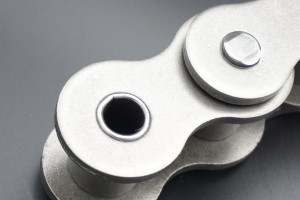When it comes to the world of chains, especially bicycle chains, the terms “bicycle chain” and “ANSI roller chain” are often used interchangeably. But are they really the same? In this blog, we will reveal the differences between bicycle chain and ANSI roller chain, clarifying their unique characteristics and functions.
What is ANSI Roller Chain?
First, let’s understand what ANSI roller chain is. ANSI stands for American National Standards Institute and is responsible for developing guidelines and standards for various industries. Therefore, ANSI roller chains adhere to these specific standards, ensuring high quality and reliability.
Typically, ANSI roller chains consist of inner plates, outer plates, pins, rollers and bushings. These components work in harmony to efficiently transmit power, making them commonly used in industrial applications such as conveyor systems, agricultural machinery, and even motorcycles.
Is the bicycle chain an ANSI roller chain?
While bicycle chains may have similarities to ANSI roller chains, they are not necessarily the same. As the name suggests, bicycle chains are specifically designed for bicycles and their main purpose is to transfer power from the rider’s legs to the bicycle’s wheels.
While some bicycle chains may indeed be ANSI compliant, it’s worth noting that not all bicycle chains are classified as ANSI roller chains. Bicycle chains generally have a simpler design, consisting of inner links, outer links, pins, rollers, and plates. Their construction is optimized for the specific requirements of the bicycle, such as weight, flexibility and ease of maintenance.
Notable features:
Now that we’ve established that bicycle chains don’t have to be ANSI roller chains, let’s take a deeper look at their salient features.
1. Size and Strength: ANSI roller chains are available in a variety of sizes with larger sizes being used for heavy duty applications. Bicycle chains, on the other hand, come in standard sizes that match your bike’s specific gear system. They are designed to carry smaller loads than industrial roller chains.
2. Lubrication and Maintenance: ANSI roller chains require regular lubrication to ensure smooth operation and prevent premature wear. Bicycle chains also benefit from regular lubrication, but they are often designed with built-in maintenance features, such as self-lubricating mechanisms or O-ring seals, reducing the need for frequent maintenance.
3. Abrasion Resistance: ANSI roller chains are engineered to withstand extreme conditions such as high temperatures or abrasive environments. In contrast, bicycle chains are mostly exposed to weather elements and normal wear and tear, making them less resistant to harsh conditions.
while there may be some overlap in terminology, it is important to distinguish between bicycle chains and ANSI roller chains. Bicycle chains are specifically designed for bicycles while ANSI roller chains are versatile, durable and can be used in a wide range of machinery applications. Understanding these differences is critical when choosing the right chain for your specific needs.
Whether you are a cycling enthusiast or an engineer looking for an industrial grade chain, knowing the difference between bicycle chain and ANSI roller chain will allow you to make an informed decision and ensure optimal function of your chosen chain system.
Post time: Aug-04-2023

